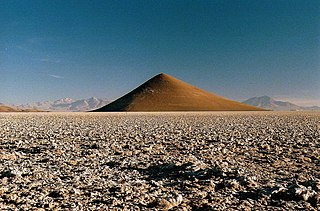
A glacier is a persistent body of dense ice that is constantly moving under its own weight; it forms where the accumulation of snow exceeds its ablation over many years, often centuries. Glaciers slowly deform and flow due to stresses induced by their weight, creating crevasses, seracs, and other distinguishing features. They also abrade rock and debris from their substrate to create landforms such as cirques and moraines. Glaciers form only on land and are distinct from the much thinner sea ice and lake ice that form on the surface of bodies of water.

Death Valley is a desert valley located in Eastern California, in the northern Mojave Desert bordering the Great Basin Desert. It is one of the hottest places in the world along with deserts in the Middle East.

Owens Valley is the now-arid valley of the Owens River in eastern California in the United States, to the east of the Sierra Nevada and west of the White Mountains and Inyo Mountains on the west edge of the Great Basin. The mountain peaks on either side reach above 14,000 feet (4,300 m) in elevation, while the floor of the Owens Valley is about 4,000 feet (1,200 m), making the valley one of the deepest in the United States. The Sierra Nevada casts the valley in a rain shadow, which makes Owens Valley "the Land of Little Rain." The bed of Owens Lake, now a predominantly dry endorheic alkali flat, sits on the southern end of the valley.
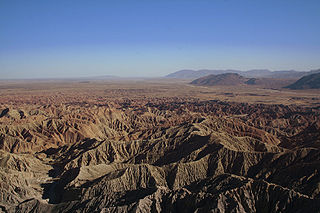
Anza-Borrego Desert State Park (ABDSP) is a California state park located within the Colorado Desert of southern California, United States. The park takes its name from 18th century Spanish explorer Juan Bautista de Anza and borrego, the Spanish word for sheep. With 600,000 acres (240,000 ha) that includes one-fifth of San Diego County, it is the largest state park in California.

Coulee, or coulée is a term applied rather loosely to different landforms, all of which refer to a kind of valley or drainage zone.
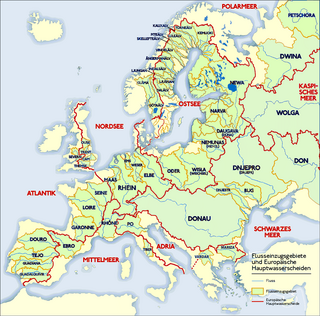
A drainage divide, water divide, divide, ridgeline,, watershed, water parting or height of land is elevated terrain that separates neighbouring drainage basins. On rugged land, the divide lies along topographical ridges, and may be in the form of a single range of hills or mountains, known as a dividing range. On flat terrain, especially where the ground is marshy, the divide may be harder to discern.

A trough is an elongated (extended) region of relatively low atmospheric pressure, often associated with fronts. Troughs may be at the surface, or aloft, or both under various conditions. Most troughs bring clouds, showers, and a wind shift, particularly following the passage of the trough. This results from convergence or "squeezing" which forces lifting of moist air behind the trough line.

In geology, a trough is a linear structural depression that extends laterally over a distance. Although it is less steep than a trench, a trough can be a narrow basin or a geologic rift. These features often form at the rim of tectonic plates. There are various oceanic troughs, troughs found under oceans; examples include:

The Cedar Mountain Wilderness is located in northwestern Utah, United States, just south of Interstate 80. The vegetation on the upper elevations of the Cedar Mountains is dominated by junipers. The foothill and valley regions include mixed desert shrubs. Cheatgrass is prevalent over large areas burned by range fires. The remains of an aragonite mining camp can also be found in the foothills.

The Trough of Bowland is a valley and high pass in the Forest of Bowland Area of Outstanding Natural Beauty, Lancashire, England.

A gat is a strait that is constantly eroded by currents flowing back and forth, such as tidal currents. It is usually a relatively narrow but deep, up to 30 m (100 ft) passage between land masses or shallow bars in an area of mudflats. A gat is sometimes a shallower passage on lagoon coasts, including those without any tidal range.
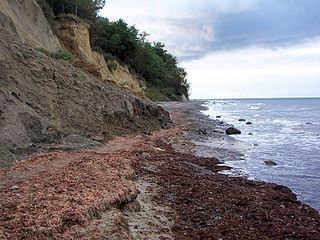
A wash margin or wash fringe is an area of the shore on which material is deposited or washed up. It often runs along the margin of a waterbody and there can be several bands due to variations in water levels. As a result of the richness of nutrients that occur in such wash fringes, ruderal species frequently occur here, that, for example, on the Baltic Sea coast consist of grassleaf orache and sea kale.
The Elsinore Trough is a graben rift valley in Riverside County, southern California. It is created by the Elsinore Fault Zone.
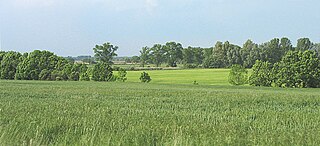
The term Luch is German and refers to an area of originally expansive, marshy or boggy lowland in northeast Germany, especially in the state of Brandenburg. Luche are found mainly in Young Drift regions; but they also occur on Old Drift landscapes. According to Leser the term should not be translated.

A high valley or high-level valley is a valley in the upper third of a mountain range. More loosely it can refer to any mountain valley.

A cirque stairway or sequence of cirque steps is a stepped succession of glacially eroded rock basins. Their individual formation is that of a cirque.

A truncated upland, truncated highland or bevelled upland is the heavily eroded remains of a fold mountain range, often from an early period in earth history. The term Rumpfgebirge was first introduced into the literature in 1886 by Ferdinand von Richthofen. The rumps of the former mountain ranges may be found in many lowland regions of the earth's crust and especially outcrop in Central Europe through more recent tectonics. This could result in an uplifted peneplain which is one type of truncated upland.
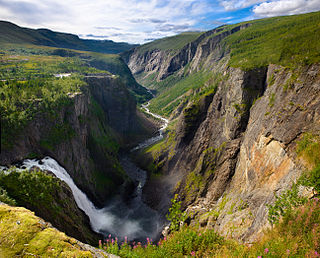
A valley step is a prominent change in the longitudinal slope of a valley, mainly in trough valleys formed by glaciers.








